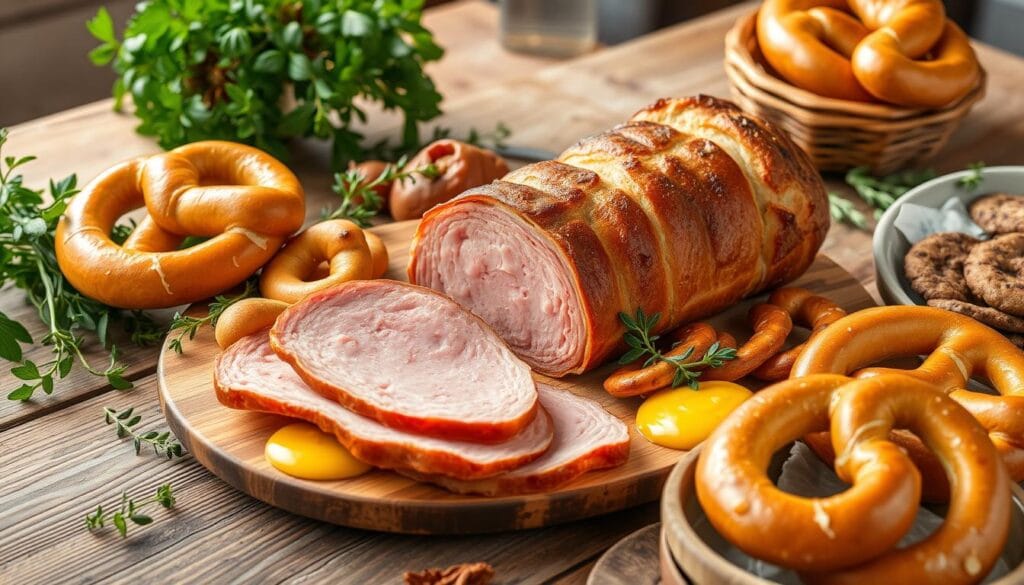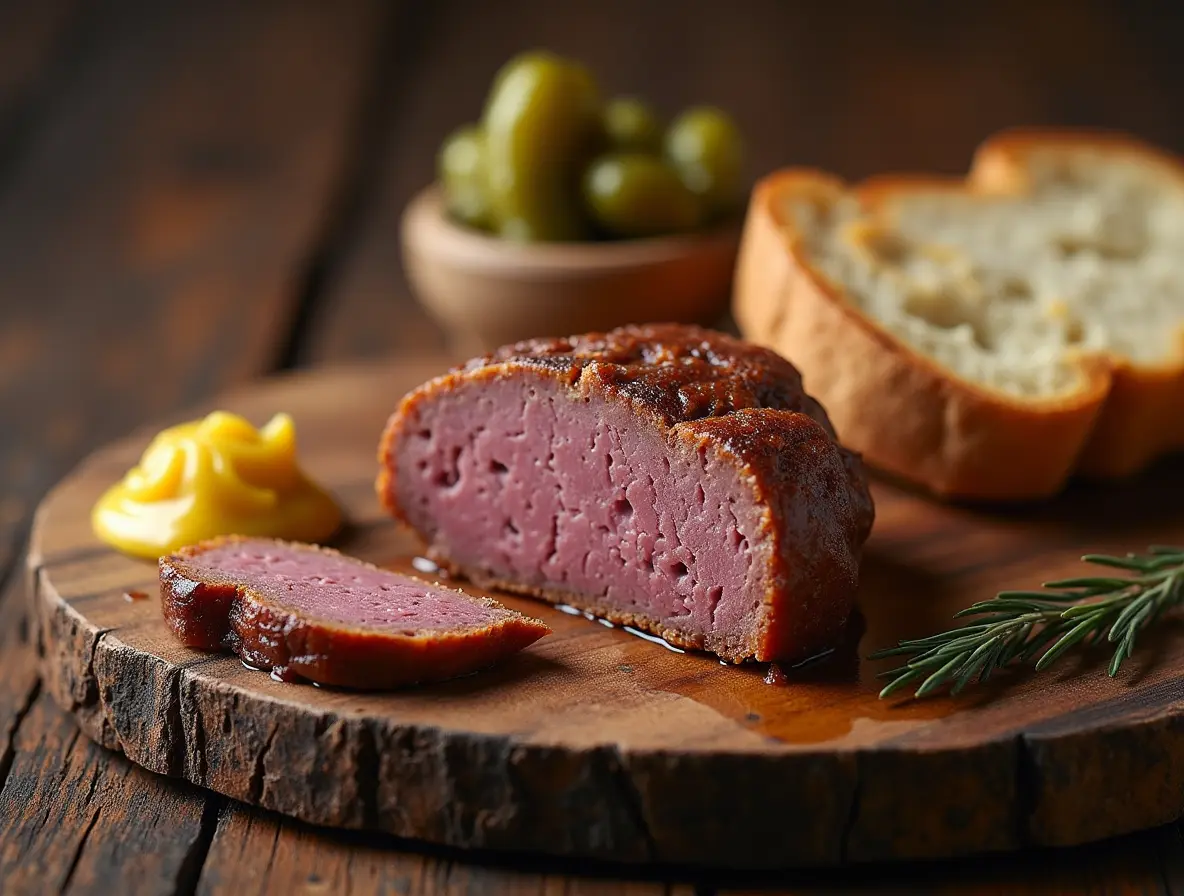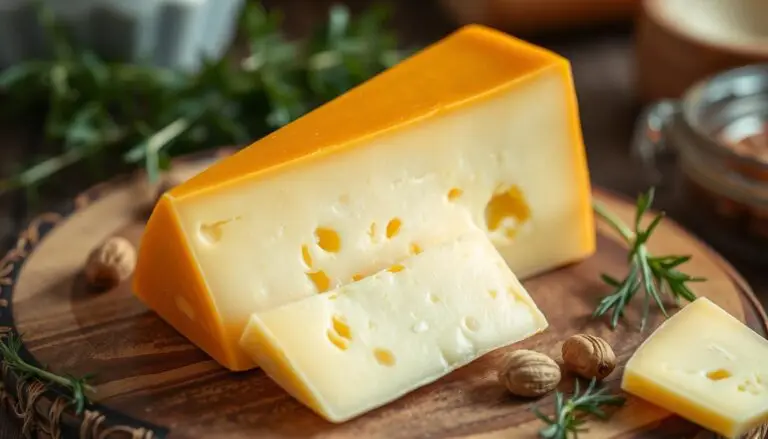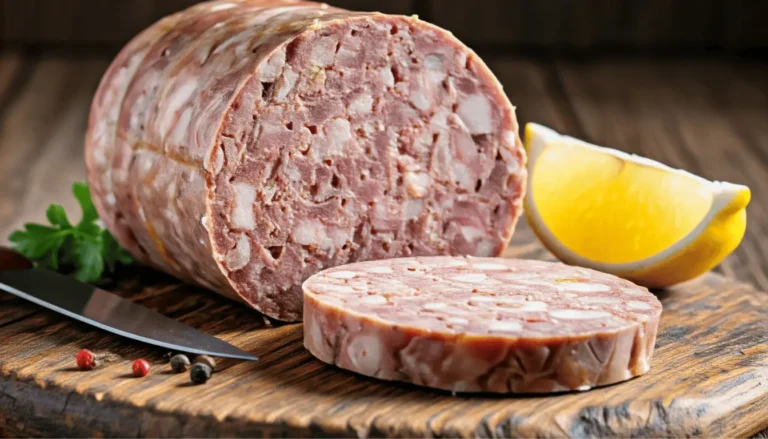Liver Cheese: A Traditional German Delicacy Guide
I love exploring Germany’s rich food traditions. The dish that really caught my eye is liver cheese, or Leberkäse. It’s a meatloaf that’s been loved in Bavaria and Austria for ages. Its story is fascinating.
Liver cheese doesn’t actually have liver or cheese. It’s a mix of pork, bacon, and beef that’s baked into a crispy loaf. It’s a highlight of German charcuterie, showing off the country’s skill in making sausages and dishes from offal.
Table of Contents
Understanding What Liver Cheese Really Is
“Liver cheese” or Leberkäse in German, doesn’t have liver or cheese. Its name comes from “Laib” (loaf) and “Kas” (consistency), showing its shape and texture. This gourmet cheese is a baked specialty. While some versions include liver, true Bavarian Leberkäse doesn’t.
The Origins and Etymology
Leberkäse started in 1776, created by Charles Theodore’s cook. It was made from pork byproducts and offcuts. This resulted in a tasty, sausage-like artisanal product.
Common Misconceptions About Ingredients
- Authentic Leberkäse doesn’t have liver, despite its name.
- It’s made from ground pork, pork fat, and seasonings like salt.
- Some recipes add beef or veal, but liver is not common.
Traditional Preparation Methods
Making Leberkäse traditionally involves mixing the meat and baking it in a loaf pan. This creates a brown crust and binds the ingredients. It gives Leberkäse a unique texture.

This gourmet cheese is a key part of Bavarian and German food. It offers a special taste and cultural importance. It’s loved by both old fans and newcomers.
The Cultural Significance of Liver Cheese in German Cuisine
Leberkäse is a favorite in German cuisine. It’s made from pork and veal, with a bit of liver. This dish is key to the “Brotzeit” or “Abendbrot” meals in Bavaria and Austria.
These meals are filled with bread, cold cuts, cheeses, and pickled veggies. They follow the German saying: “eat breakfast like a king, lunch like a prince, and dinner like a pauper.” Leberkäse is loved in beer gardens, at celebrations, and as a quick snack.
The name “leberkäse” has two possible origins. It might come from “loaf of bread” and “edible mass,” or from a mistranslation. But, leberkäse has become a cultural symbol. The Bavarian version might include pork, veal, or even horse meat.
Leberkäse is tied to history and famous figures. In the late 18th century, Karl Theodor’s lifestyle included a slaughterhouse at Schwetzingen Palace. Chefs like Paul Tremo and André Noël likely created leberkäse there.
“Leberkäse is not only a delicious part of German cuisine but also a reflection of the country’s rich cultural heritage and traditions.”
Today, leberkäse is still loved by many. It shows the lasting impact of this traditional German dish.

Popular Varieties and Regional Differences
Leberkäse, a savory German “liver cheese” delicacy, has many regional styles and flavors. In Bavaria, the original version doesn’t have liver. Instead, it’s a mix of minced pork, bacon, and spices. There are many Bavarian variations, like Käseleberkäse (with melted cheese) and Pikant Leberkäse (with spicy peppers).
Traveling eastward, Austrian versions of Leberkäse might have slight differences. For example, Presswurst, Sulz, or Schwartamaga are terms for head cheese in western Austria. It’s often served with vinegar, sunflower seed oil, or pumpkin seed oil, and sliced onions.
Modern adaptations of Leberkäse are also emerging. Now, vegan options are becoming more popular at seasonal markets and festivals. These plant-based versions are getting better in taste and texture. They meet the growing demand for gourmet versions of this traditional German foie gras-like delight.

Serving Suggestions and Pairings
Leberkäse, a traditional German dish, is great in many ways. It’s often served hot in a bread roll with mustard or ketchup. This makes for a cozy and tasty meal. You can also enjoy it cold, like cured meats, for a more elegant touch.
Bars and restaurants sometimes serve Leberkäse alone, with sides to match. They might pair it with German beers like Hefeweizen. You can also get it with potato salad, french fries, or fresh veggies. For a bigger meal, try Leberkase Schnitzel, which is breaded and fried, served with mashed potatoes or a fried egg.
Leberkäse goes well with many flavors and textures. Whether it’s a quick snack or a full meal, it’s a hit. This German dish is sure to please your taste buds and fill your belly with comfort.
FAQ
What is liver cheese?
Liver cheese, or Leberkäse in German, is a meatloaf specialty. It doesn’t actually have liver or cheese. It’s a rich, tasty dish loved in Bavaria and Austria.
What are the main ingredients in liver cheese?
Leberkäse is made from chopped pork, bacon, and beef. It’s baked into a loaf with a crusty outside.
Where does the term “Leberkäse” come from?
“Leberkäse” doesn’t mean liver or cheese. It comes from German words like “Laib” (loaf) and “Kas” (consistency). These reflect its shape and texture.
Is authentic Bavarian Leberkäse made with liver?
No, real Bavarian Leberkäse doesn’t have liver. But, other parts of Germany might use it.
How is traditional Leberkäse prepared?
It’s made by baking a mix of ground meats in a loaf pan. This creates a brown crust.
What is the cultural significance of Leberkäse in German cuisine?
Leberkäse is key in German food culture, especially in Bavaria and Austria. It’s a big part of “Brotzeit” or “Abendbrot,” traditional meals with bread, meats, cheeses, and veggies.
What are some common regional variations of Leberkäse?
There are many regional styles and flavors of Leberkäse. Examples include Käseleberkäse (with melted cheese), Pikant Leberkäse (spicy), Chilileberkäse (hot chili), Pferdeleberkäse (horse meat), and Wildschweinleberkäse (wild boar).
Are there any modern adaptations of Leberkäse?
Yes, there are modern versions like vegan Leberkäse. These are getting more popular at markets and are improving in taste and texture.
How is Leberkäse typically served?
It’s often enjoyed hot in a bread roll (Semmel) with mustard or ketchup. You can also have it cold, like ham. Some places offer it in a fancier way.
What are some common pairings and accompaniments for Leberkäse?
It goes well with German beers, especially Hefeweizen. It’s often with potato salad, french fries, or fresh veggies. For a bigger meal, try Leberkase Schnitzel with mashed potatoes or a fried egg (Strammer Max).







